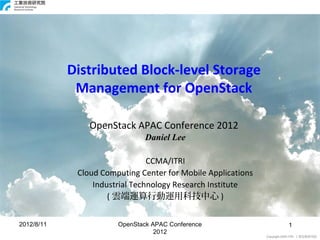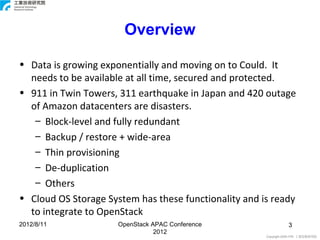Ad
Distributed Block-level Storage Management for OpenStack, by Danile lee
- 1. Distributed Block-level Storage Management for OpenStack OpenStack APAC Conference 2012 Daniel Lee CCMA/ITRI Cloud Computing Center for Mobile Applications Industrial Technology Research Institute ( 雲端運算行動運用科技中心 ) 2012/8/11 OpenStack APAC Conference 1 1 2012 Copyright 2009 ITRI 工業技術研究院
- 2. Outline • Overview • Brief on ITRI Cloud OS • Cloud storage system in ITRI Cloud OS • Distributed Main Storage System • Distributed Secondary Storage System • Integration of Cloud OS Storage System with OpenStack • Summary • Q&A 2012/8/11 OpenStack APAC Conference 2 2012 Copyright 2009 ITRI 工業技術研究院
- 3. Overview • Data is growing exponentially and moving on to Could. It needs to be available at all time, secured and protected. • 911 in Twin Towers, 311 earthquake in Japan and 420 outage of Amazon datacenters are disasters. – Block-level and fully redundant – Backup / restore + wide-area – Thin provisioning – De-duplication – Others • Cloud OS Storage System has these functionality and is ready to integrate to OpenStack 2012/8/11 OpenStack APAC Conference 3 2012 Copyright 2009 ITRI 工業技術研究院
- 4. ITRI Cloud OS (An All-in-one IaaS Total Solution) Virtual Data Center Management Primary/Secondary Virtual Data Center Storage Management Physical Data Provisioning (VMWare) (EMC) Center Management Physical (IBM) Resource Security Management (Checkpoint) (HP/Dell) Inter-VM Load Balancing (F5) Power Management (IBM) Inter-PM Load Balancing and VM Fail-over (VMWare) *Blue name in bracket indicates the leading company of the component 2012/8/11 OpenStack APAC Conference 4 2012 Copyright 2009 ITRI 工業技術研究院
- 5. ITRI Cloud OS Service Interface Multiplexing VDC’s in a Physical DC Multiplexing VDC’s in a Physical DC Virtual Data Center Management Physical Data Center Management Virtual Data Center Management Physical Data Center Management Photo Video Web Sharing Streami Confere ng nce VDC VDC Provision VDC and Deploy Physical •Cloud Application Cluster •Cloud Service Infrastructure Developer Administrator •Cloud Service •Carrier Provider Monitor and Configure Monitor, Diagnose and Virtual Resources Configure Physical Resources 2012/8/11 OpenStack APAC Conference 5 2012 Copyright 2009 ITRI 工業技術研究院
- 6. VDCM – Assets (VDC, VC, VM) 2012/8/11 OpenStack APAC Conference 6 2012 Copyright 2009 ITRI 工業技術研究院
- 7. VDCM – System Images 2012/8/11 OpenStack APAC Conference 7 2012 Copyright 2009 ITRI 工業技術研究院
- 8. VDCM - Volumes 2012/8/11 OpenStack APAC Conference 8 2012 Copyright 2009 ITRI 工業技術研究院
- 9. Cloud Storage System in Cloud OS • Cloud storage aims at cloud-scale data centers, and is designed to be scalable, available and low-cost. • Main components – Distributed Main Storage subsystem – DMS • Provide current image I/O request processing – Distributed Secondary Storage subsystem – DSS • Block-level incremental metadata only backup system • Take volume snapshot / restore, de-duplication engine, garbage collection and WADB engine 2012/8/11 OpenStack APAC Conference 9 2012 Copyright 2009 ITRI 工業技術研究院
- 10. Key Features of Cloud Storage System from Users’ Perspective • Use like raw, unformatted block devices • Support volume size from 1 GB to 2 TB (64TB architecture-wise) • Can be attached by different instances (one at a time for now) • Multiple volumes can be mounted to the same instance • Data is automatically replicated on different physical storage server (N=3) • Ability to clone volumes and/or create point-in-time snapshots of volumes • Wide-area backup for disaster recovery • Snapshot can be scheduled by assigning a backup policy with time, frequency, retention, and WADB option • Save system image for starting multiple VMs using the same image 2012/8/11 OpenStack APAC Conference 10 2012 Copyright 2009 ITRI 工業技術研究院
- 11. Key Features of Cloud Storage System from Providers’ Perspective • Use of commodity hardware – reducing cost (JBOD) • Disk space management for up to multiple petabytes • Add disk, remove disk without interruption • Thin provisioning • Enables you to provision a specific level of I/O performance if desired, by setting I/O throttle • Block-level de-duplication for reducing space requirement 2012/8/11 OpenStack APAC Conference 11 2012 Copyright 2009 ITRI 工業技術研究院
- 12. DMS in Cloud OS • DMS - Distributed Main Storage • Goal: A cloud scale network storage solution that provide high capacity, high reliability, high availability and high performance • Features: – Volume operations: Create / Attach / Detach / Delete – High Reliability: data replication (N=3) – High Availability: No single point of failure – High Performance: client-side metadata/data cache for performance – Thin provisioning is utilized to optimize utilization of available storage. – Fast Volume Cloning – Save Image; FastBoot – Disk I/O Throttle 2012/8/11 OpenStack APAC Conference 12 2012 Copyright 2009 ITRI 工業技術研究院
- 13. DMS System Architecture Compute Node … VM VM VM Service Node Volume Volume Volume Metadata DMS In-kernel client NameNode Data RR Storage Node … DMS three components: 1. Namenode DataNode 2. DMS in-kernel client 3. Datanode 2012/8/11 OpenStack APAC Conference 13 2012 Copyright 2009 ITRI 工業技術研究院
- 14. DMS Compute Node Architecture Compute Node Domain U User Space Domain U Kernel Space Applications RPM Read/Write Sectors /dev/hda1 Block Frontend Driver Attach/Detach Attach a disk to Dom U Volume Xen / KVM I/O Virtualization Block Backend User-space Daemon Driver NameNode IOCTL Metadata In-Kernel Client Payload DataNodes Block Devices /dev/dms01 /dev/dms02 . .. .. Domain 0 User Space Domain 0 Kernel Space 2012/8/11 OpenStack APAC Conference 14 2012 Copyright 2009 ITRI 工業技術研究院
- 15. Read Flow Compute Node VM Volume Service Node 6. Response 1. Read request (payload) 2. query metadata: (VolID, LBID) DMS In-kernel Client 3. HBID, N-locations NameNode 7. Report failed locations 4. Read Data 5. Read Data from another datanode if previous-try failed Storage Node Storage Node Storage Node DataNode DataNode DataNode … OpenStack APAC Conference 2012 Copyright 2008 ITRI 工業技術研究院 2012/8/11 15
- 16. Write Flow – Memory-Ack Approach Compute Node VM Volume Service Node 6. Response 1. Write request 2. Request for new space:(VolID, LBID) DMS In-kernel Client 3. HBID, N-locations NameNode 7. Commit (Success, or 4. Write Data report failed locations) 5. Memory Ack 6. Disk Ack • Memory-ack approach: Storage Node Storage Node Storage Node In client, I/O response to VM(step6) is right after DataNode DataNode DataNode … receiving memory ack from Datanodes (step5) . OpenStack APAC Conference 2012 Copyright 2008 ITRI 工業技術研究院 2012/8/11 16
- 17. DSS in Cloud OS • Share the homogeneous space with DMS • Block-level Incremental backup – Copy-on-write (COW) and volume cloning techniques – Backup is just a snapshot of meta-data • Support volume-level restore • Block-level de-duplication • Garbage collection of expired, un-used and redundant disk blocks • Wide-area data backup / restore and near-realtime replication • The secondary storage itself is failure-tolerant (HA) 2012/8/11 OpenStack APAC Conference 17 2012 Copyright 2009 ITRI 工業技術研究院
- 18. DSS – Backup Policy 2012/8/11 OpenStack APAC Conference 18 2012 Copyright 2009 ITRI 工業技術研究院
- 19. DSS – Assign Backup Policy 2012/8/11 OpenStack APAC Conference 19 2012 Copyright 2009 ITRI 工業技術研究院
- 20. DSS – WADB Backing up the data to a remote location at the time volume snapshot is taken… snapshot Network / restore VPN Beijing Shang-Hai 2012/8/11 OpenStack APAC Conference 20 2012 Copyright 2009 ITRI 工業技術研究院
- 21. DSS – Enabling WADB 2012/8/11 OpenStack APAC Conference 21 2012 Copyright 2009 ITRI 工業技術研究院
- 22. De-duplication in DropBox 2012/8/11 OpenStack APAC Conference 2012 Copyright 2009 ITRI 工業技術研究院 22
- 23. DSS Software Architecture Diagram Backup/Restore Backup Policy Request Tread DSS main SOAP server Classes RPC DSS Daemon DSS Manager Thread Manager / Flow Control Restore Quartz Snapshot Scheduler Timer WADB Fired Garbage Collection DB manager De-dup DMS client protocol RS client Lib Scheduler De-dup Engine DMS RS 2012/8/11 OpenStack APAC Conference 23 2012 Copyright 2009 ITRI 工業技術研究院
- 24. OpenStack Web Interface Identity Security Compute Storage Network Architectures Object Hypervisors Block File Switch Router Firewall (ARM, GPU) (Swift) 2012/8/11 OpenStack APAC Conference 24 2012 Copyright 2009 ITRI 工業技術研究院
- 25. Integration of Cloud OS Storage System with OpenStack User portal Web Services User (OpenStack VDCM LOG PDCM PDCM User API enabled) VMM L2 PRM Nova API Glance Nova Manager DB DMS VM1 VM2… VMn Nova Volume volume … Nova Compute Nova Network SECS RS SLB 2012/8/11 OpenStack APAC Conference 25 2012 Copyright 2009 ITRI 工業技術研究院
- 26. Summary of Advantages Feature Benefits Unlimited storage highly scalable read/write access Leverages commodity hardware (JBOD) No lock-in, lower price/GB Built-in replication Fully redundant (default: N=3) Used as system volume Save Image, Fast Boot, etc. Thin Provisioning Optimize utilization of available storage Highly available (HA) storage servers Server failover for high available (DMS/DSS) Snapshot and backup for block volumes Data protection and recovery for VM data Policy based backup Free of worry – set it and forget about it Wide-area data backup For disaster recovering Block-level data de-duplication Store more data in the limited space Standalone volume API, CLI available Easy integration with other compute systems 2012/8/11 OpenStack APAC Conference 26 2012 Copyright 2009 ITRI 工業技術研究院
- 27. More Feature in V2.0 Feature Benefits Volume Cloning Fast cloning without copying data Share virtual disk within cluster Support sharing of volume and cluster file system Disk bandwidth QoS guarantee Dynamic adjustment at I/O request level Storage space optimization N-way replication for write-intensive blocks N-parity-group for read-intensive blocks Wide-area data replication Near real-time wide-area replication Integration with Compute / Volume Fully integrated to Compute for attaching block volumes and reporting on usage 2012/8/11 OpenStack APAC Conference 27 2012 Copyright 2009 ITRI 工業技術研究院
- 28. Q&A Thank You ! Copyright 2009 ITRI 工業技術研究院
Editor's Notes
- #3: Why don’t we just use Hadoop as block level storage What are the advantages over iSCSI – RAID + SW for backup restore and WADB When will it be available for OpenStack – 4Q2012? The limitations? Volume / total space, size of metadata, network, … Performance? 12 MB/sec or 49 MB/sec (multiple concurrent clients) How does it compare to EMC, Amazon S3? S3: Object Store; AWS Import/Export Amazon Elastic Block Storage (EBS): 1GB~1TB; ss saved in S3 Cinder, NetApp, Nexenta and SolidFire CIFS, GlusterFS, OCSF2 XCP
- #13: CRITICAL CHANGES NO HDFS In-kernal driver “ Native” networking disk driver (not xen back-end driver) Key design Why we Why not use iscii protocol Datanode prioritization Datanode hardware dependency
- #14: Provides a global storage abstraction on a large number of distributed disks Each storage block remains available despite failure in switch, server, or disk drive Scales to a very large number of concurrent accesses Exploits distributed object caching Initial thought: Use HDFS as the base for global storage management Support concurrency control among accesses to common storage blocks Support QoS guarantee or performance isolation among virtual clusters




















































































































